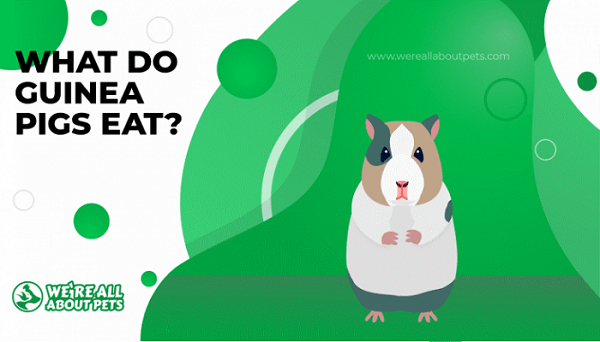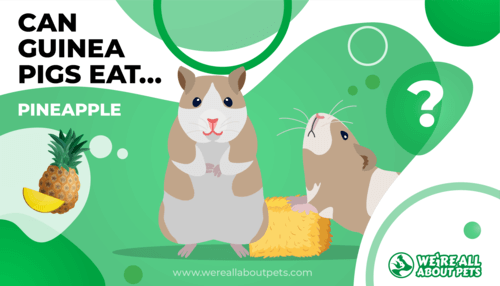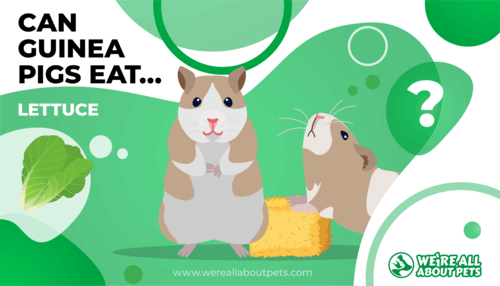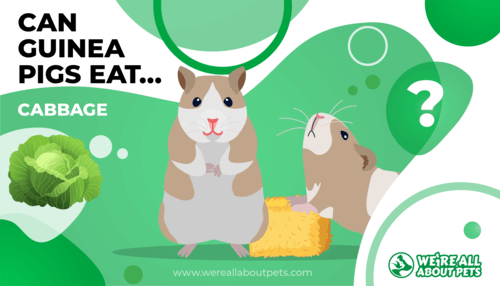What Do Guinea Pigs Eat?
This page contains affiliate links. We may earn money or products from the companies mentioned in this post through our independently chosen links, which earn us a commission. Learn More

Guinea pigs are a small pet known for their sweet personalities and adorable pig-like squeal.
Despite the name, however, guinea pigs are in no way related to actual pigs.
They are domesticated rodents, bred from the species Cavia porcellus, hence the name and also their nickname, the cavy.
Though originally native to South America, guinea pigs no longer exist in the wild.
The guinea pig is an adorable little pet that, though skittish at first, can become very comfortable with people. They need plenty of space to run as well as hiding places to make sure they feel safe.
In addition to providing your guinea pig with a comfy home, you also need to provide a balanced diet.
Your guinea pig’s diet is actually very simple, but it is important to follow. If you don’t feed your guinea pig right, you could damage its digestive system and cause severe health problems.
With a healthy diet, guinea pigs can live between 4 and 8 years.
Read on to learn the basics about what you can and cannot feed your pet guinea pig and to learn more about its nutritional needs.
Quick Navigation
Safe and Unsafe Fruits, Veg Foods for Guinea Pigs

If you find yourself asking “what do guinea pigs eat”, the answer is just about anything plant based.
Just because your guinea pig can eat it, however, doesn’t mean it should. We’ve assembled a list of dozens of foods that are and aren’t safe for your pet guinea pig. Check them out below!
22 Foods That Are Safe for Guinea Pigs:
- Timothy hay
- Alfalfa hay (limited)
- Commercial pellets
- Asparagus
- Beet greens
- Dandelion greens
- Endive
- Romaine lettuce
- Kale
- Carrot tops
- Cauliflower
- Squash
- Brussels sprouts
- Broccoli
- Celery
- Zucchini
- Fresh herbs
- Cucumber
- Green beans
- Spinach
- Green peppers
- Turnip greens
12 Foods Guinea Pigs Can Eat in Moderation:
Fresh hay, commercial pellets, and fresh veggies should be the staples of your guinea pig’s diet. To supplement your pet’s nutrition, however, you can also offer small amounts of fruit such as:
- Apples
- Bananas
- Oranges
- Pears
- Strawberries
- Blueberries
- Kiwi
- Papaya
- Peaches
- Cantaloupe
- Tomatoes (fruit only)
- Watermelon
9 Foods That Are Not Recommended for Guinea Pigs:
Most fresh vegetables and fruits are fine for guinea pigs, but there are some that offer limited nutritional value or the wrong concentration of nutrients. Here are some foods that aren’t recommended for guinea pigs:
- Iceberg lettuce
- Seeds
- Cabbage
- Bok choy
- Dairy products
- Corn
- Whole grains
- Nuts
- Bread or pasta
16 Foods Toxic or Harmful to Guinea Pigs:
- Avocados
- Buttercup flowers
- Beans
- Cereal
- Tomato plants
- Onions
- Chives
- Garlic
- Coconut
- Chocolate
- Coffee
- Mushrooms
- Nuts
- Potatoes
- Rhubarb
- Meat
Understanding which foods are and are not safe for your guinea pig is very important, but you also need to understand your guinea pig’s nutritional requirements if you want it to be healthy. Read on to learn the specifics of what to feed your guinea pig at different ages.
Types of Guinea Pig Diets
When it comes to your guinea pig’s diet, there are several important things to remember. First and foremost, guinea pigs are strict herbivores – they only eat plant foods. Next, remember that your guinea pig’s teeth grow constantly. Guinea pig hay is high in fiber and helps keep your pet’s teeth filed down. Fiber is also essential for a healthy digestive system.
Finally, know that guinea pigs can’t synthesize their own vitamin C which makes them prone to scurvy. Fresh fruits can provide a natural source of vitamin C, but you may also want to treat your pet’s water with vitamin C drops to be safe.
Here is a quick breakdown of the different components of a pet guinea pig’s diet:
- Fresh Hay – Fresh grass hay should make up the majority of your guinea pig’s diet and be available in unlimited quantities at all times.
- Commercial Pellets – Guinea pig pellets should be made primarily from grass hay, ideally timothy hay. Baby guinea pigs and pregnant or nursing mothers may benefit from alfalfa pellets.
- Fresh Vegetables – Fresh veggies like leafy greens should be offered daily, about 1 cup per guinea pig. Be sure to include a variety over the course of the week.
- Fresh Fruits – Small amounts of fruit can be included in your pet’s diet to provide a natural source of vitamin C, but you don’t need to offer it every day.
- Treats – Many pet shops sell guinea pig treats like yogurt drops, but these are not recommended because they may contain sugar. You can offer your guinea pig chews made of hay or wood or even a salt lick.
Now that you know what kinds of foods will make up your guinea pig’s diet, you’re probably curious to know how much to feed it. Keep reading to learn about feeding recommendations for pet guinea pigs.
Meeting Your Pet Guinea Pig’s Nutritional Needs
A healthy guinea pig diet is high in fiber with moderate protein content and low fat. Guinea pig hay is the staple of the diet for guinea pigs of all ages, though the type of hay may vary.
For baby guinea pigs, calcium is important to develop strong bones, so alfalfa hay is usually the better choice.
Because it is high in protein and lower in fiber, however, alfalfa hay should be swapped with timothy hay once the guinea pig reaches its adult size.
When choosing your guinea pig’s diet, it’s important to understand its digestive system. Guinea pigs are similar to rabbits in that they have a cecum, a thin-walled organ that is connected to the small intestine and colon.
It contains bacteria that help digest high-fiber food, though it may still take 20 hours for a meal to pass completely through the digestive tract.
Something else to know about guinea pigs is that they cannot pass gas or regurgitate food.
Bloating and gas can be very dangerous, so avoid or limit foods that cause gas like cabbage, cauliflower, bok choy, and broccoli. High-fiber foods are best and making sure your guinea pig has plenty of water to drink can help prevent digestive issues.
To give you an idea what do guinea pigs eat and much you should be feeding your pet guinea pig in different stages of life, refer to this chart:
Daily Guinea Pig Feeding Chart |
||||
| Age | Size | Fresh Hay | Veggies and Fruits | Pellets |
| Up to 4 months | Baby | Alfalfa and timothy, equal but unlimited amounts of both | Lettuce (small amounts), high-vitamin C fruits | Alfalfa-based (unlimited amounts) |
| 4 months and up | Adult | Timothy and other grass hay, unlimited amounts | 1 cup fresh veggies per day, small amounts of fruit several times a week | Timothy-based (2 tablespoons) |
| Pregnant and nursing mothers | Adult | Alfalfa and timothy, equal but unlimited amounts of both | 1 cup fresh veggies per day, small amounts of vitamin C-rich fruit several times a week | Timothy-based (2 tablespoons) |
In addition to feeding your guinea pig a high-quality diet, you also need to provide plenty of fresh water. A water bottle generally works best for guinea pigs, so make sure you have one full at all times.
Know that guinea pigs sometimes like to push bits of food into the spout of the water bottle, so check multiple times daily and clean the bottle as needed.
Recommended Commercial Guinea Pig Foods
When it comes to healthy guinea pig food, all brands are not created equal. Many commercial guinea pig food options are loaded with wheat products instead of grass hay like timothy.
Keep a lookout for that and make sure you choose a pellet that contains mostly timothy hay, not alfalfa – alfalfa hay is only recommended for very young guinea pigs and pregnant or nursing mothers.
Here are some of our top picks for the best commercial guinea pig food:
- Oxbow Western Timothy Hay – If you’re looking for high-quality hay to feed your guinea pig, this Western timothy hay is an ideal option. It is 100% natural and loaded with dietary fiber.
- Small Pet Select Guinea Pig Pellets – Made with only the finest ingredients, these timothy-based pellets are milled in small batches to ensure high quality and freshness.
- Kaytee Timothy Complete Guinea Pig Food – These timothy-based pellets are a great option for your guinea pig, plus they contain added vitamin C to help prevent scurvy.
Looking for more recommendations on what to feed your guinea pig? Check out our in-depth guide to the best commercial guinea pig foods.
Hopefully by now you understand the basics about feeding your pet guinea pig, but we understand if you still have a few questions. Here are the answers to some common questions about guinea pigs.
Guinea Pig Feeding FAQs
What do guinea pigs eat in the wild?
Guinea pigs no longer exist in the wild. They were originally domesticated by the Incas over 3,000 years ago from the rodent species Cavia porcellus. Though wild guinea pigs no longer exist, they subsisted on a diet very similar to pet guinea pigs – hay, leaves, grass, and flowers as well as other vegetables, seeds, and possibly some fruit.
How much do guinea pigs eat?
The average guinea pig needs about 1/8 cup (2 tablespoons) of high quality pellets a day along with an unlimited amount of fresh timothy hay. Fresh veggies can be offered once a day – about 1 cup per guinea pig – and fresh fruit can be offered a few times a week in small amounts as a treat.
What do guinea pigs drink?
Guinea pigs drink water and it is very important for a healthy digestive system. A guinea pig needs about 100ml of fresh water per day, though some may drink less if they eat a lot of fresh food.
Do guinea pigs eat insects?
Guinea pigs are strictly herbivores, so they don’t eat meat or insects.








